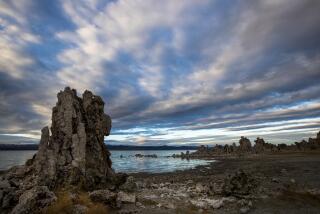NASA Probes Mono Lake to Find Clues to Life on Mars : Science: Researchers explore likely cradles of life on Earth to help design the next interplanetary lander.
- Share via
SAN FRANCISCO — Almost 160 feet below the surface of one of the oldest lakes in North America, a robot eases across the murky bottom on an extraterrestrial mission--searching for life on Mars.
Scientists think the strange ivory-colored spires that awe tourists at Mono Lake may also exist on the Red Planet.
If so, their deposited coating, called tufa, could hold the elusive proof that life on Earth is not alone.
“It’s the Jurassic Park effect, like trapping a mosquito in amber,” said paleontologist Jack Farmer of the National Aeronautics and Space Administration’s Ames Research Center. “The organisms get trapped in the tufa and preserved.”
NASA’s mission to 3-million-year-old Mono Lake grew out of the frustrating results of Viking landers sent to Mars in the 1970s.
Although soil sample results were tantalizing, scientists found no conclusive evidence that life had existed in the reddish soil 50 million miles from Earth.
But Mars seems to have the makings of life--or at least it did millions of years ago.
Geologists are certain that water once flowed freely across the face of Mars. And Mars has an atmosphere, although it is thin. Temperatures, although extreme by Earth standards, don’t rule out life.
Could there be pockets of fossilized creatures, possibly microbes, somewhere on the planet? If so, where should the next Mars probe look?
To answer those questions, NASA scientists turned to Earth and asked where life developed here.
One theory that attracted biologists was the possibility that bacteria developed around upwellings of water heated by volcanic activity on the ocean floor, or in salty, water-filled, mineral-laden basins--like Mono Lake.
“There is strong evidence that all life on Earth evolved from such bacteria and that life’s origins trace back to hydrothermal vents,” said project director Carol Stoker. “They are especially good sites for preservation of a fossil record.”
Mars also has basins that were likely once hypersaline lakes located near volcanic hot springs. The heat and chemicals would have kept water from freezing even in Mars’ frigid temperatures, and are ideal for breeding bacteria.
“If there were microbes on Mars, they would have loved spring outflows, particularly in an alkaline lake like Mono,” Farmer said.
Mono Lake, just east of Yosemite National Park in the Sierra, is believed to be the second-oldest in North America, after nearby Lake Tahoe. But unlike Tahoe, it has no outflow, meaning water leaves only by evaporation.
That makes Mono three times saltier than the sea. And in some locations, underwater hot springs raise its temperature to near boiling, said marine biologist Debra Stakes.
In August, Stoker and researchers from the Monterey Bay Aquarium Research Institute, the Naval Postgraduate School and Stanford University gathered at Mono Lake to explore its vents and tufa-covered spires.
The star of the experiment was NASA’s underwater robot named TROV--Telepresence Controlled Remotely Operated Vehicle.
The TROV is equipped with a state-of-the-art high-frequency sonar system, an acoustic positioning system developed by Desert Star Systems of Moss Landing, stereoscopic cameras and a sample-grabbing arm. The robot was operated from a houseboat on Mono Lake’s surface via 1,000 feet of cable.
The high-tech robot is itself part of the Mars experiment. Something like the TROV will travel to that planet, perhaps as early as 2003, to search for life, and the bugs must be worked out on Earth, Stakes said.
The TROV team’s search for the underwater mounds was unexpectedly tough, said Tony Healey of the Naval Postgraduate School, who helped set up the probe’s electronic eyes.
“The vision was only a foot or so with the two stereoscopic cameras,” he said. “It was the murkiest they’d ever encountered.”
The chemical quality of the water at the lake bottom was so peculiar that the sonar operated at a range of only two meters instead of the 30 meters Healey had expected.
But despite the adversity, the TROV found the base of pinnacles covered with tufa, which is deposited out of the water by chemical-- and possibly biological--action. Samples will be analyzed over the next few months to see how well they preserve microbes.
Although Mars is the immediate goal of the NASA research, there’s no reason to stop there, Stoker said.
“Hydrothermal environments could occur elsewhere in the solar system, such as on various satellites of the outer planets Jupiter, Saturn and Neptune,” she said.






